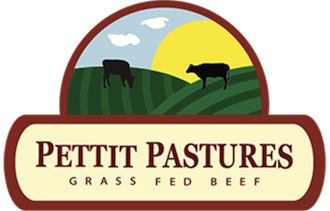Pettit Pastures January 2015
The new year is here and January is going by so quickly I can hardly believe it is almost over. The weather has been fairly mild for a typical Minnesota winter. We had a few weeks with below normal temperatures but we have had little snow and now are currently back above normal temps.
We are currently feeding the cows balage. Balage is cut forage like alfafa, grasses, and clovers. Once the forage is cut, we let it dry down to about 60% moisture. This usually takes one to two days. After it reaches the right moisture, we bale it into large round bales. Then we wrap the bales in plastic wrap to ferment, just like silage would. Because of the fermentation process, balage retains greater amounts of nutrients than dried hay does.
We have been feeding this balage since November. Last week, we decided to weigh some of the calves to see how much weight they were gaining on our balage. We averaged 0.4 pounds a day per calf. This is not a bad weight gain during a Minnesota winter. It is definitely more than we were gaining last year, when we fed dry hay. However, last summer, we grazed the same field that the balage was cut from and we averaged almost 2 pounds per day of weight gain. The cows do burn more calories in the winter trying to stay warm, but not nearly enough calories to cause over a pound and a half of weight gain diffrence. The rest of the calories and nutrients are lost preserving the forage.
[/et_pb_text][/et_pb_column][/et_pb_row][et_pb_row _builder_version=”3.19.3″][et_pb_column type=”3_5″ _builder_version=”3.19.3″ parallax=”off” parallax_method=”on”][et_pb_text _builder_version=”3.19.3″]This got me thinking about our own food system. How much nutrition is lost when we ship food across the country or even the world? How many nutrients get lost every time our food is processed, preserved, and packaged? I don’t have any exact amounts for the questions above, but I do think it is safe to say that we are losing nutrients from our food every time it is modified, handled, or processed. I think this is the reason that vegetables from our own gardens or meat from local butchers taste better than the ones we buy in the grocery store. I also think this is a great reason to buy as much of your food locally as you can.[/et_pb_text][/et_pb_column][et_pb_column type=”2_5″ _builder_version=”3.19.3″ parallax=”off” parallax_method=”on”][et_pb_image src=”https://www.pettitpastures.com/wp-content/uploads/2019/01/jan-2015.jpg” _builder_version=”3.19.3″][/et_pb_image][/et_pb_column][/et_pb_row][/et_pb_section]
